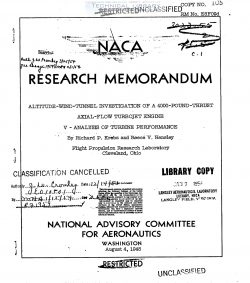naca-rm-e8f09d
- Version
- 51 Downloads
- 943.81 KB File Size
- 1 File Count
- April 21, 2017 Create Date
- April 21, 2017 Last Updated
National Advisory Committee for Aeronautics, Research Memorandum - Altitude Wind Tunnel Investigation of a 4000 Pound Thrust Axial Flow Turbojet Engine - V - Analysis of Turbine Performance

Performance characteristics of the turbine of a 4000-pound-
thrust axial-flow turbojet engine were determined in investigations
of the complete engine in the NAGA Cleveland altitude wind tunnel.
Characteristics are presented as functions of the total-pressure
ratio across the turbine and of turbine speed and gas flow corrected
to sea-level conditions.
Three turbine nozzles of different areas were used to deter-
mine the area that gave optimum performance. Inasmuch as tail-pipe
nozzles of different diameters were investigated in combination with
the standard turbine nozzle, the effect of varying discharge condi-‘
tions on turbine operation could be observed.
The investigations covered a range of pressure altitudes from
5000 to 40,000 feet. The engine was investigated over the entire
operable range of speeds at each altitude. At a pressure altitude
of 50,000 feet, the effect on turbine operation of varying the ram
pressure ratio over a range from 1.10 to 1.77 was evaluated.
An altitude effect was apparent when turbine pressure ratio
was plotted against corrected turbine speed but it was so slight
as to be negligible insofar as the turbine efficiencies were con-
cerned. A maximm turbine efficiency of slightly more than
82 percent was obtained with the configuration using the standard
turbine nozzle and the low-flow compressor. This efficiency, which
is somewhat lower than the actual turbine efficiency, is uncorrected
for accessories drive power, bearing friction, tail-pipe pressure
drop", compressor thermal radiation, and introduction of turbine-
disk cooling air into the gas stream. Changes in the ram pressure
ratio had a negligible effect on the turbine efficiency.
An investigation of the altitude performance and the operational
characteristics of the iOOO-pound-thruet axial-flow turbo Ijet engine
and its component parts has been conducted in the NAGA Cleveland alti-
tude wind tunnel. Summaries of the over-all performance and opera-
tional characteristics of the engine are given in references 1 to 3
and the compressor performance is given in reference 4.
| File | Action |
|---|---|
| naca-rm-e8f09d Altitude Wind Tunnel Investigation of a 4000 Pound Thrust Axial Flow Turbojet Engine - V - Analysis of Turbine Performance.pdf | Download |

Comment On This Post